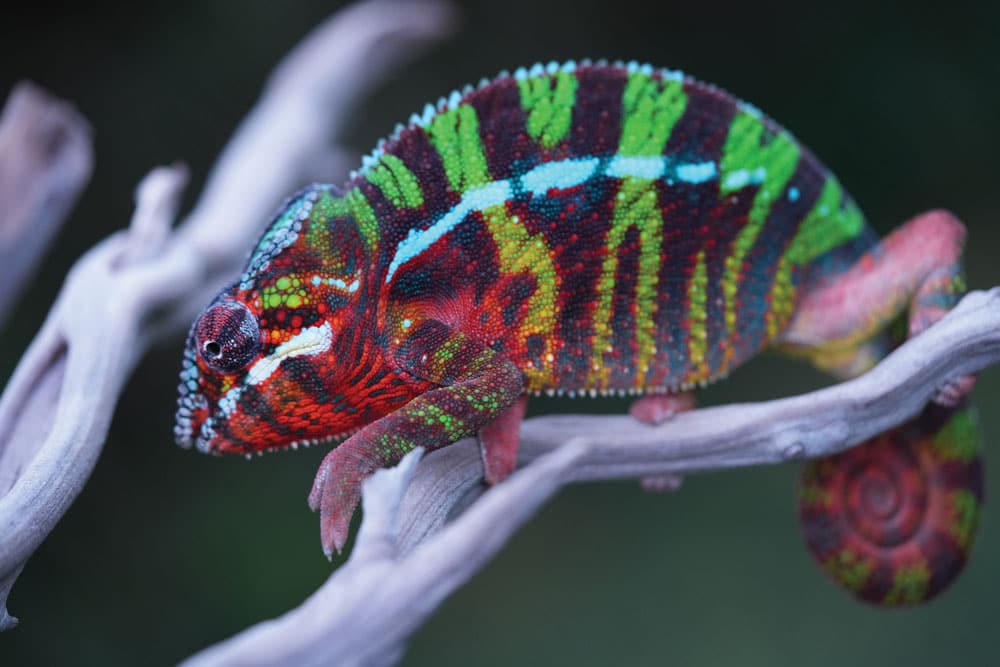Ensuring an ideal environment for panther chameleons in captivity has become significantly more manageable.
Panther chameleons, (Furcifer pardalis), are one of the most striking reptiles found in the world. Originating from the rainforests of Madagascar, these reptiles captivate herpetoculturists with their vibrant colors, unique anatomy and behaviors. We at iPardalis, LLC, are going on our 10th year breeding them and are currently incubating our 7th generation of Ambilobe locality panther chameleons. We’ll delve into their natural history, breeding habits, and care requirements to ensure their well-being in captivity.
Natural History
Panther chameleons are endemic to Madagascar, a large island nation off the southeastern coast of Africa. Within Madagascar, they inhabit a variety of environments ranging from coastal forests and islands to mountainous regions, with each locality adapted to meet its own set of challenges and opportunities. Many species of chameleons specialize in very specific habitat and elevation niches, but panther chameleons are able to inhabit a wider range of habitats. They have a broad range of thermal conformity with wild cloacal vent temperatures ranging from 73 degrees to 97 degrees Fahrenheit (22.7 to 36.1 degrees Celsius). They also inhabit locations that receive less than 40 inches of rain with seven to eight dry months per year and other locations with more than 100 inches of rain and zero dry months per year. This could be why hobbyists have been more successful with them in captivity. They have evolved to survive in many different environmental conditions.
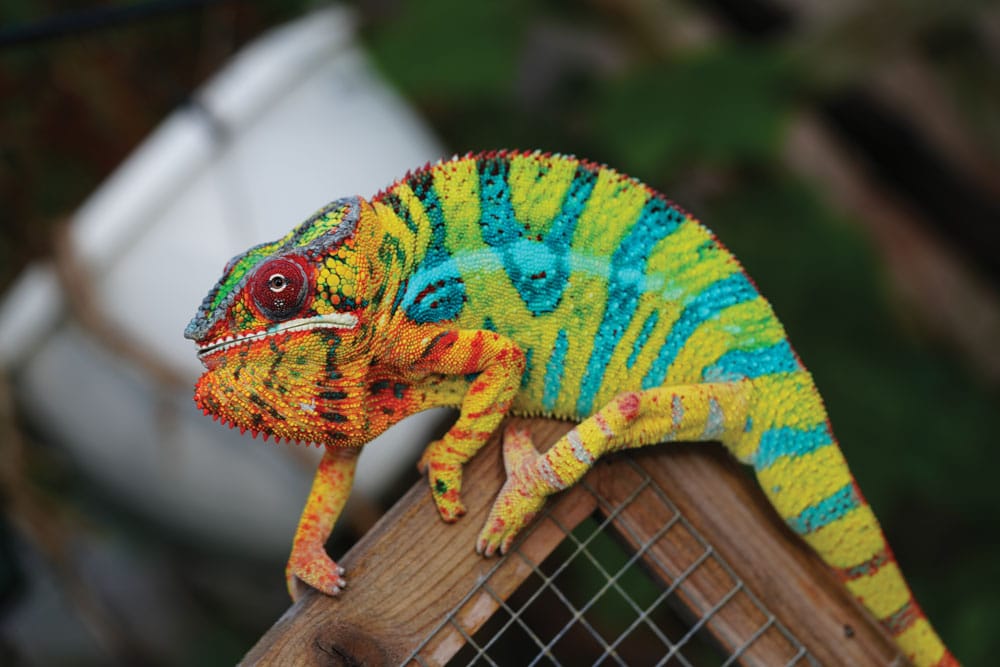
A panther chameleon climbs up on its enclosure.
Photo by Jon Hill
These arboreal reptiles are primarily found in the eastern and northern regions of Madagascar, including areas such as Nosy Be, Nosy Boraha (formerly known as Île Sainte-Marie), and the Marojejy and Montagne d’Ambre National Parks. Most of the primary plant communities in Madagascar have been destroyed or severely degraded by human activity. Panther chameleons are one of the lucky species that seem to thrive in degraded habitat and even around human dwellings or agricultural land. The Oustalet’s Chameleon (Furcifer oustaleti) occupies a similar niche and their range overlaps, so there is some very interesting research on their interspecific competition.
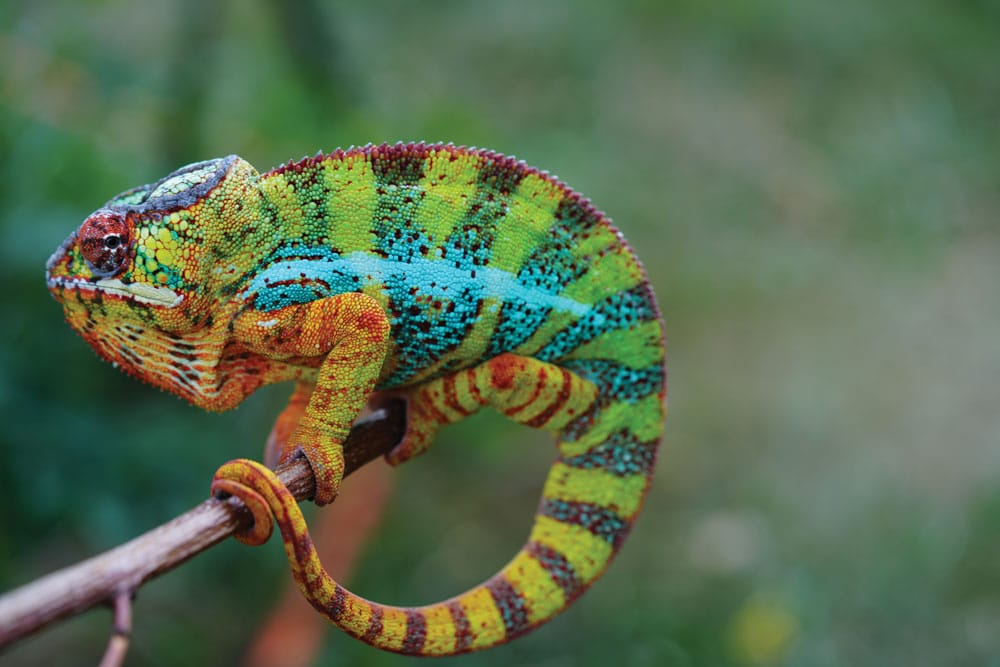
These arboreal reptiles are primarily found in the eastern and northern regions of Madagascar, including areas such as Nosy Be, Nosy Boraha (formerly known as Île Sainte-Marie), and the Marojejy and Montagne d’Ambre National Parks. Photo by Jon Hill
Many local populations of panther chameleons are geographically isolated from each other where they have drifted genotypically and phenotypically from the rest of the species. Panther chameleons are renowned for their remarkable variety of colors and local forms from solid pink (Ankaramy) to solid blue (a subset from Nosy Be) to many di-chromatic body-bar combinations where they got their common name “Panther” chameleon. Like all chameleons, they change color to communicate and thermoregulate rather than to camouflage with their surroundings. Their coloration can vary greatly depending on factors such as mood, season, temperature, diet and light intensity. Males are typically more vibrant, showcasing the color of one of their locality’s predominant phenotypes, while females exhibit more subdued tones to blend into their surroundings and avoid attracting predators. This sexual dimorphism makes it possible to gain some insight into where a male panther chameleon originates from while that is not true for female panther chameleons.
Breeding
Male panther chameleons are extremely intolerant of each other during breeding season, and combat in an enclosed, captive environment could prove fatal for the loser. Many wild specimens have been viewed with considerable damage, scars and wounds that have recently scabbed over. Both males and females should be housed separately, but especially males due to the risk of injury and death after intense bouts of combat.
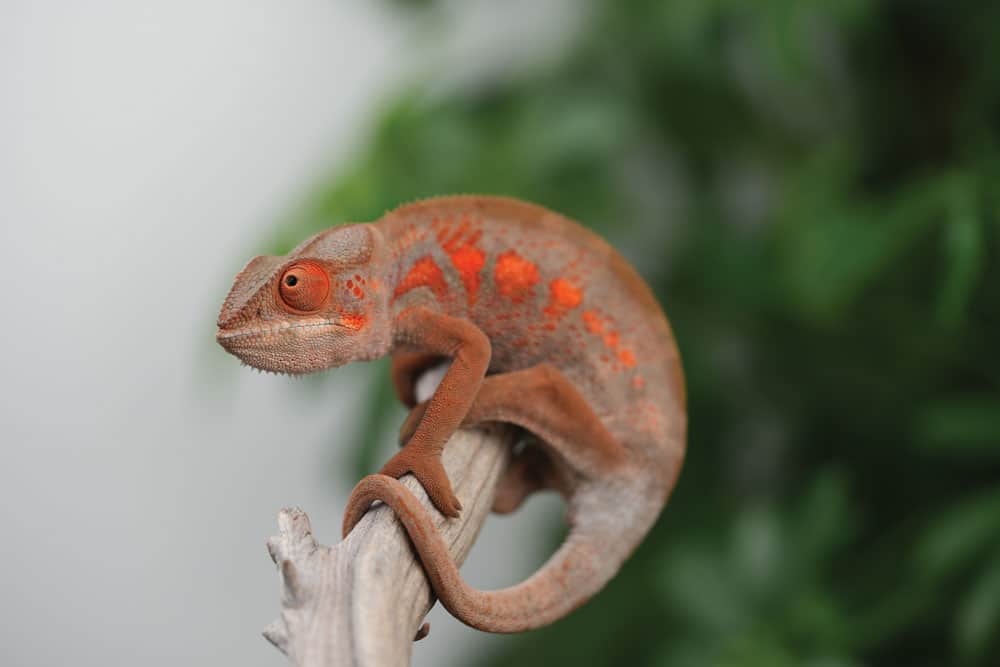
A female displaying the pink hue, indicating she is ready to breed. Photo by Jon Hill
Breeding typically occurs in the warmer months, with males engaging in elaborate courtship displays to woo receptive females. Receptive females have beautiful orange, pink, purple and even blue hues. There have been a few observations of panther chameleons mate guarding and remaining together for a few months during the breeding season, but they quickly separate into social isolation. If a female panther chameleon is interested in breeding, she’ll maintain her pink hue and accept a male’s advances, leading to copulation that can last several hours.
Unlike some reptiles, panther chameleons do not require multiple mating sessions. While constant supervision isn’t necessary, it’s important to check on them regularly to ensure everything is going smoothly. If the male becomes too aggressive, it’s crucial to separate them promptly because females are much smaller in size and can be injured severely (even fatally) if they fight in an enclosed space.
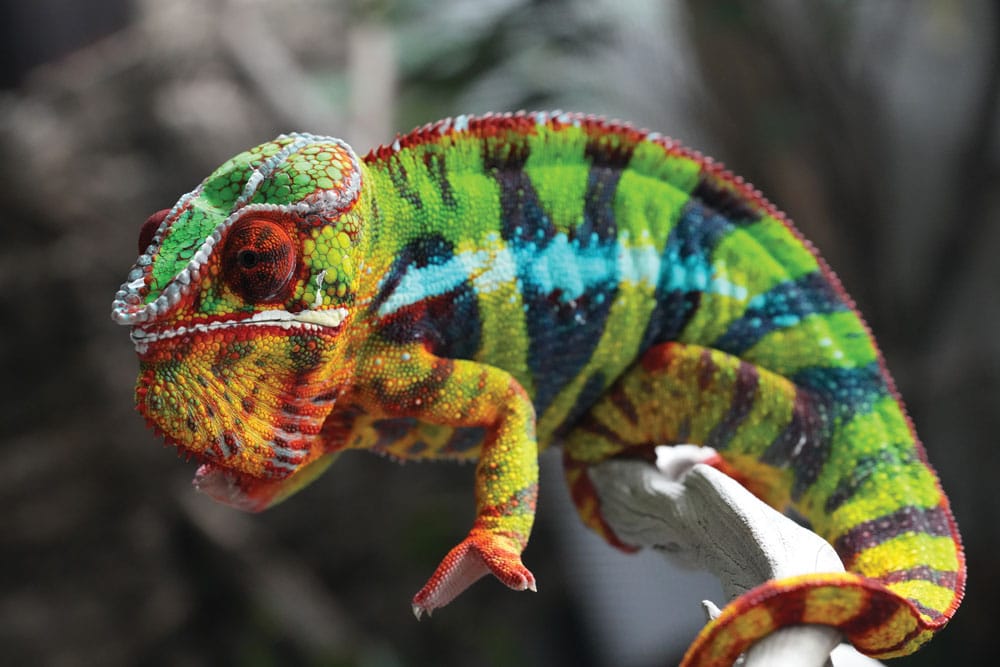
Breeding occurs in the warmer months. Courtship of females can last several hours, though there have been instances when the partners stay together for a few months during breeding season. Photo by Jon Hill
Once mating is successful, females will turn black and open their mouth, rocking back-and-forth with their mouth open in the presence of a courting male. Females search for suitable sites to deposit their eggs, often choosing areas with packed, sandy soil at the base of a small plant. This may be especially important in regions where there is a true dry season because the plant can collect moisture and keep the ground from trapping the babies when they are ready to emerge. This helps explain why some females prefer laying in potted plants or against root balls in captivity.
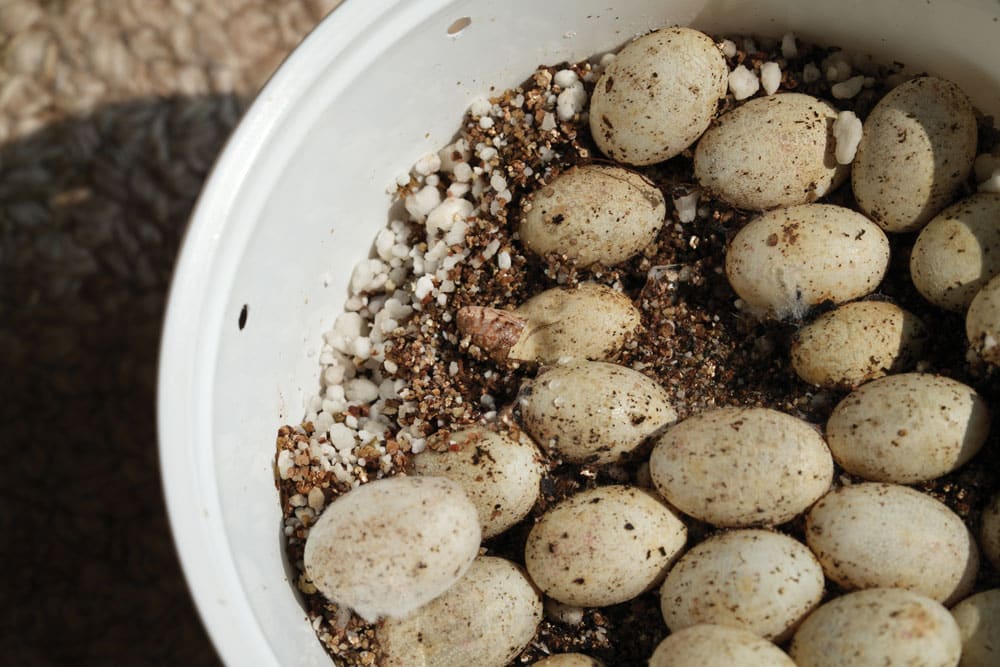
The author’s clutch sizes range from 12 to 46 eggs. See the baby pipping. Photo by Jon Hill
Clutch sizes range from 12 to 46 eggs. In captivity, we have been trying to keep clutch sizes below 25 to prolong and improve the lives of female panther chameleons because complications from egg laying can severely limit their length and quality of life.
Around 20 to 30 days after mating, the female will stop eating until she’s ready to lay eggs. When you notice her exploring the bottom of the enclosure, give her privacy and make sure she always has access to a lay bin. This bin should be 4-6 inches deep and filled with moist sandy soil capable of holding a tunnel – preferably with a live plant and decent sized rock to provide various laying options. A 5-gallon bucket or small rubber tub works well for this purpose outside the enclosure, but you can also provide a fully planted bioactive substrate inside her enclosure. Simply leave her alone until her nose is covered in sand and her body is skinny post-lay.
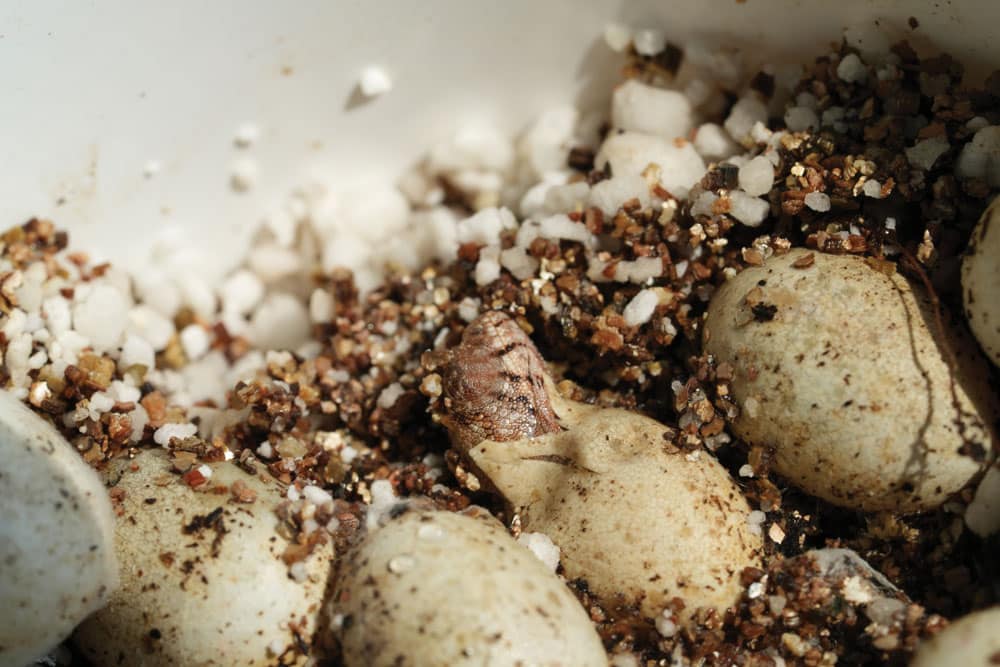
A panther chameleon emerges from its egg. The author places the eggs into a sealed container in a cool dark closet for 6 to 12 months. Photo by Jon Hill
We have personally had a female lay five clutches back-to-back on a single pairing and the most I am aware of was a Nosy Be female that laid nine consecutive clutches over 412 days. This multi-clutch potential complicates breeding significantly due to the unknown progeny of babies after multiple males have been bred to the same female.
It’s best not to observe the female while she digs or lays eggs, as this can startle her and lead to potential abandonment of the hole, risking egg retention and health issues (remember – one of the most dangerous periods in a female’s life is when she is exposed to predators, depositing her eggs). After laying, she’ll fill in the hole herself. Carefully excavate the eggs, keeping them in the same orientation as you found them. Place the eggs in a sealed container with damp incubation media. You can achieve the desired level of dampness by soaking the media and then gently squeezing it until only a few drops emerge. There are a few media mixes these days which include water crystals which can absorb excess water – no need to squeeze them.
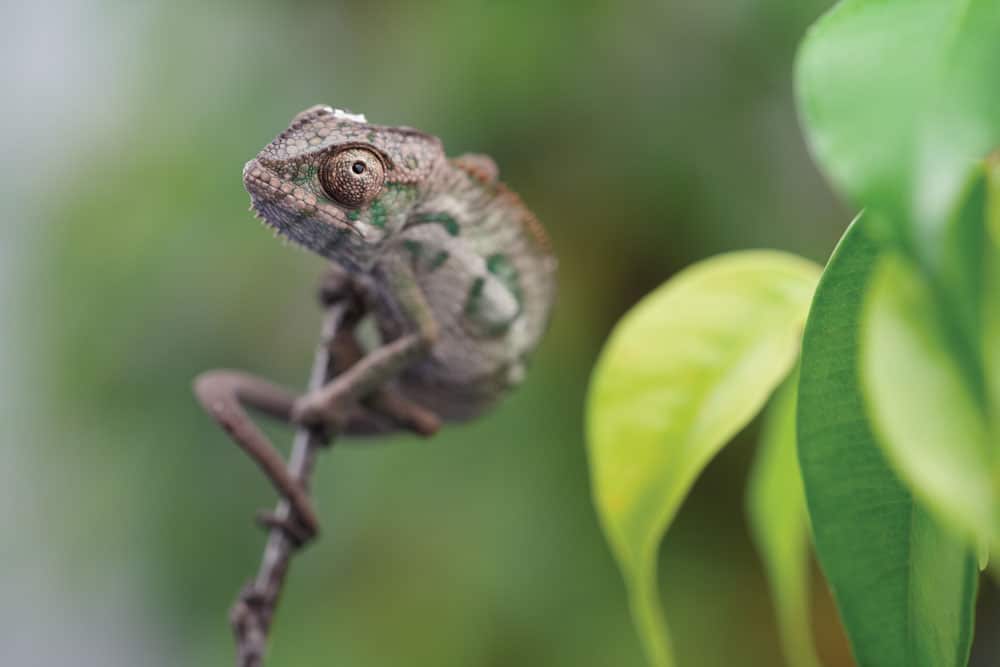
A baby panther chameleon on a twig. After hatching, the babies quickly disperse.
Photo by Jon Hill
Incubation temperatures do not play a role in determining the sex of the offspring. Panther chameleons have genetically determined sex (females have ZzW chromosomes and males have ZzZz chromosomes). Store the sealed container in a cool, dark closet and refrain from disturbing the eggs for 6 to 12 months. While we don’t open our containers to aerate them, we do drill two to three one-sixteenth-inch holes into the top. Maintain temperatures between 70 to 78 degrees Fahrenheit (21.1 to 25.5 degrees Celsius) avoiding extremes, and aim for humidity levels of approximately 80 to 100 percent. Panther chameleons have a similar diapause period to most Furcifer and Calumma. Lower temperatures (low-mid 60s) followed by elevated temperatures (low-mid 70s) ends the diapause and accelerates development to term.
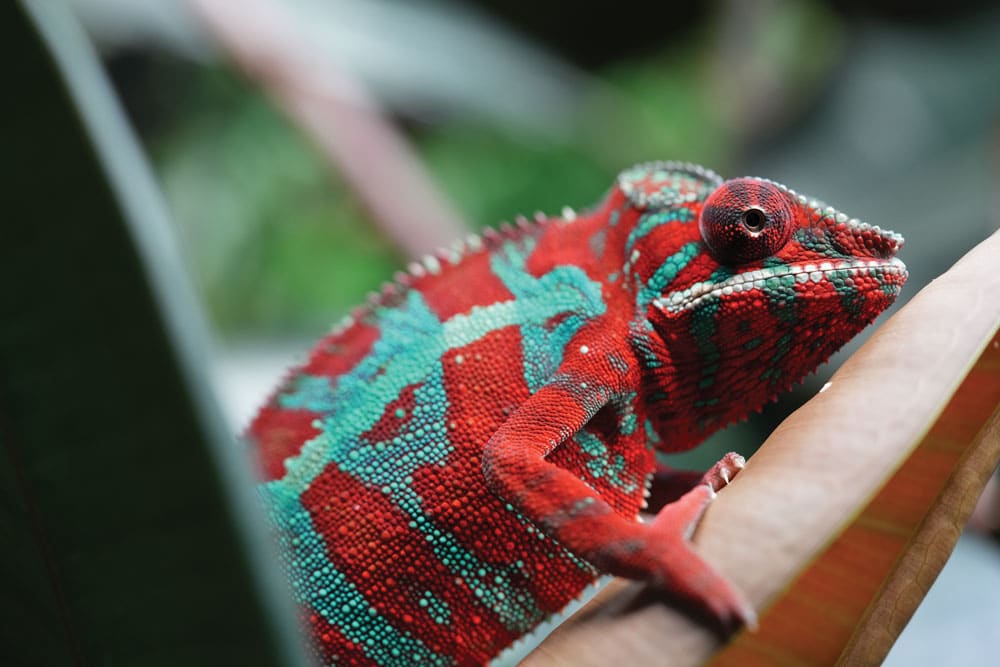
The panther chameleon is found in areas that receive more than 100 inches of rain and no dry months to 40 inches of rain and seven to eight dry months.
Photo by Jon Hill
Babies hatch and disperse quickly in the wild. In captivity, we should emulate that experience by providing forest-floor habitat and social isolation while they establish themselves. They will reach sexual maturity in about 6 months if provided optimal conditions. This is normal in our breeding program and in wild observations. Some males may take longer to reach sexual maturity and wait to the following season to show interest in females. There are numerous multi-generational breeding projects in the United States which have seen decades of success. However, most breeders still attempt to acclimate their own wild caught panther chameleons imported from a specific locality because it is very difficult to create and maintain pure locality populations in captivity due to their complex/overlapping phenotypes, ability to store sperm from previous pairings, and sexual dimorphism. You should get started with captive bred panther chameleons from a trusted source because adding acclimation to their care significantly increases the complexity and decreases your success rates.
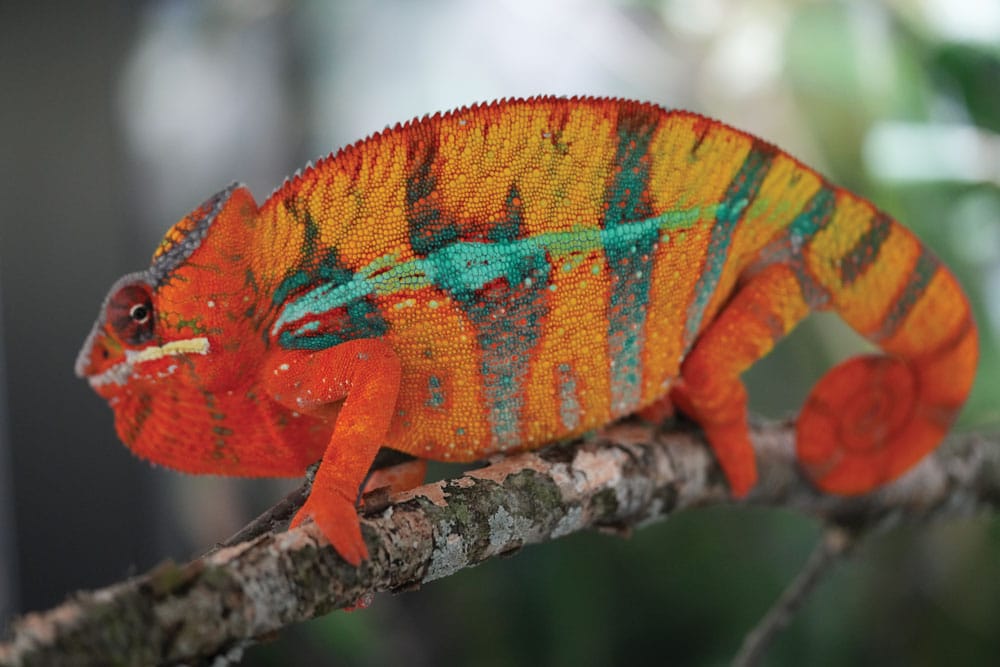
The panther chameleon colorations are stunning. Photo by Jon Hill
Panther chameleons have complex inheritance patterns that depend on many different, unidentified genes. We breed for male traits and can only estimate what traits a female is carrying given her lineage information. This is why keeping good records and working with trusted sources is especially important for panther chameleon breeders. For an in-depth look at these topics, and others, I highly recommend our blogs on Furcifer pardalis Body Color Inheritance Theory and Selectively Breeding Furcifer pardalis as well as our podcast series on Selectively Breeding Panther Chameleons.
Care Guide
Ensuring an ideal environment for panther chameleons in captivity has become significantly more manageable nowadays, as solutions to most challenges in maintaining their well-being are readily accessible. Below are key considerations for their care:
Enclosure
- Panther chameleons are arboreal, necessitating enclosures with ample horizontal space for climbing and perching, ideally located above eye height.
- A minimum enclosure size of 24 x 24 x 48 inches is recommended for adult chameleons, with larger dimensions preferred for increased comfort and enrichment.
- Provide plenty of branches, vines, and foliage to simulate their natural habitat and offer opportunities for exploration, drinking and hiding.
Heating and Lighting
- Maintaining appropriate temperatures is essential for the health and well-being of panther chameleons. Daytime temperatures should range between 70 to 80 degrees Fahrenheit (21.1 to 26.6 degrees Celsius), with a basking spot reaching 85 degrees Fahrenheit (29 degrees Celsius).
- Use a combination of heat lamps and LED plant lights to create a thermal and light gradient within the enclosure, allowing chameleons to regulate their body temperature.
- Full-spectrum UVB lighting is crucial for proper calcium metabolism and vitamin D synthesis. Ensure that UVB bulbs are replaced every 6 to 12 months to maintain their effectiveness. We often use a T5 6% Arcadia bulb, or an equivalent, such as the new Leap 5.0 T5 UVB.
Humidity and Misting
- Panther chameleons require high humidity levels and good air flow to support hydration and respiratory health. Aim for humidity levels between 40-60% during the day and 80%-100% at night, which can be achieved through regular misting and the use of a quality fogging system or whole room humidifier.
- Misting should be performed multiple times daily to simulate natural rainfall and provide chameleons with opportunities to drink water droplets from leaves and surfaces. This in combination with foggy nights is often termed “naturalistic hydration” by Bill Strand at the Chameleon Academy.
Feeding
- Panther chameleons are insectivores, primarily consuming a diet of live insects such as crickets, roaches, meal worms, and wax worms.
- Offer a variety of gut-loaded insects to ensure nutritional diversity and prevent deficiencies. Our two favorite nutritionally balanced gut loads for panther chaemelons are Cricket Crack sold by Full Throttle Feeders and Feeder Fuel Gutload produced by Ready’s Rainforest.
- Dust prey with calcium supplements every feeding to support bone health and overall vitality. Depending on your supplementation strategy, a multivitamin with vitamins A and D3 along with a full spectrum of vitamins and minerals should be provided multiple times each month. Make sure the multi-vitamin contains vitamin D3 and preformed vitamin A, not just beta carotene, because there is some evidence that panther chameleons cannot properly metabolize beta carotene into vitamin A.
Substrate and Hygiene
- If you use loose substrates such as sand or soil, make sure you cover them with leaves and include proper drainage, microfauna and nutrients to prevent harmful bacteria or fungus from developing.
- Regular spot cleaning, steaming and substrate replacement are necessary to maintain a clean and hygienic environment for your chameleon. Make sure you check for poop in the plants and vines if you see a poop on the ground.
New Developments in Care
In recent years, advancements in reptile husbandry have led to the development of innovative products and techniques to enhance the care of panther chameleons. Bill Strand, the founder of the Chameleon Academy and Owner of Dragon Strand, has been leading the way on many different fronts, experimenting with new techniques and disseminating information as the evidence grows for various improvements we make.
- Bioactive enclosures, which incorporate live plants, naturalistic substrates, and beneficial microorganisms, can offer a more sustainable and enriching habitat for captive chameleons. However, we are still learning how to adjust misting, hygiene maintenance, ventilation and parasite control strategies in these new habitats.
- New lighting options offer a full spectrum LED and UVB intensity which simulates a circadian rhythm.
Many keepers in dry/temperate climates now have numerous PVC and other solid-sided enclosure options such as Leap Habitats, Tamura Designs, and Dragon Strand that can give them more humidity control while not sacrificing too much ventilation. Ventilation is important but many people misdiagnose parasite infections and internal distress as a respiratory infection caused by stagnant air. Just a chimney effect with ventilation at the top and bottom with normal basking temps provides adequate ventilation.
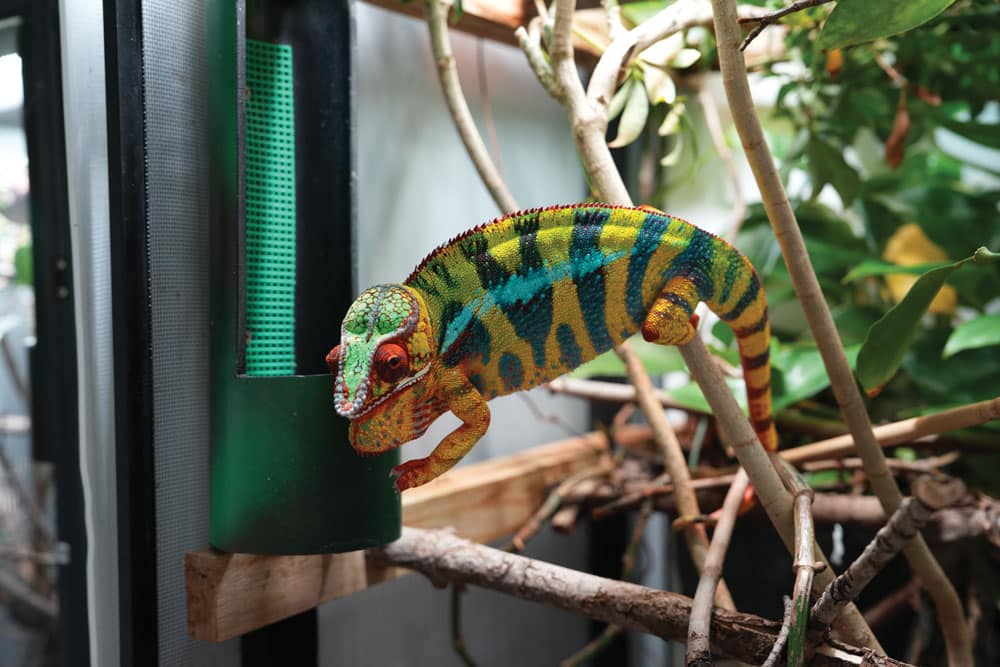
The panther chameleon needs plenty of climbing branches throughout the enclosure.
Conclusion
Panther chameleons are fascinating reptiles that require specialized care to thrive in captivity. By understanding their natural history, breeding behaviors, and specific care requirements, herpetoculturists can provide a stimulating and nurturing environment for these captivating creatures. With proper attention to enclosure design, heating, lighting, humidity, feeding, and hygiene, keepers can enjoy the beauty and charm of panther chameleons while promoting their health and well-being for years to come.
John Hill has been individually raising panther chameleons since 2015. He is the founder of Ipardalis. You can reach him at https://ipardalis.com. You can listen to Jon’s podcasts on the ChameleonAcademy.com website, YouTube, Spotify and other podcast platforms.

